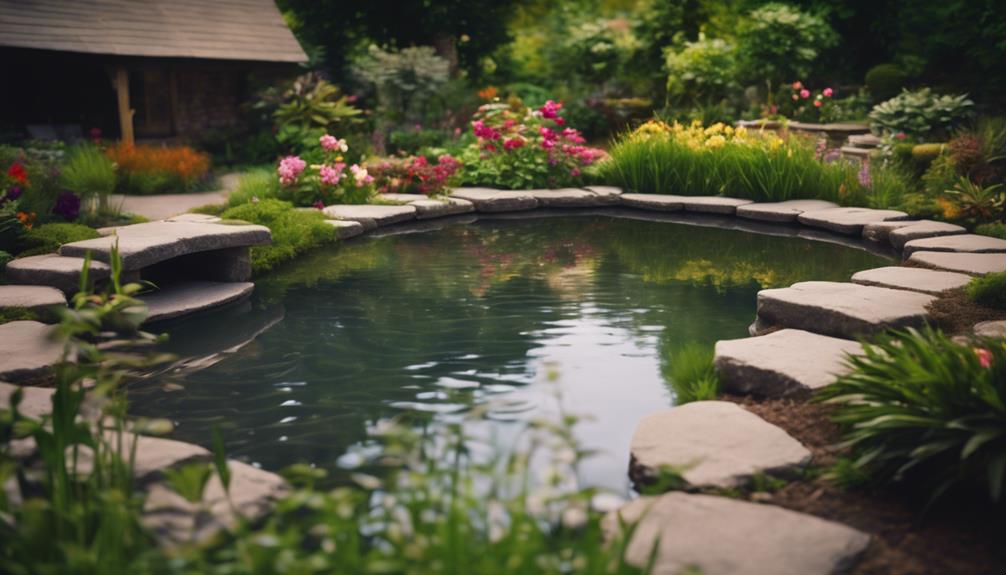You'll create a thriving small yard water garden by choosing a durable, waterproof container that's at least 10-15 gallons, with adequate drainage holes and a wide mouth. Select plants with contrasting shapes, colors, and sizes, and arrange them in layers to create a balanced ecosystem. Regularly top off the water, clean the pump and filter, and control mosquito breeding. As you master these basics, you'll discover the intricacies of designing a harmonious atmosphere, optimizing water maintenance, and incorporating innovative features to elevate your outdoor space – and that's just the beginning of your water garden journey.
Table of Contents
Key Takeaways
- A durable, waterproof, and algae-resistant container is crucial for a small yard water garden, with a minimum capacity of 10-15 gallons.
- A thoughtful plant selection creates a visually stunning and thriving ecosystem, with a mix of submerged, emergent, and floating plants.
- Regular water maintenance, including top-offs and changes, helps maintain water quality and prevents mosquito breeding, with weekly 10-20% water changes recommended.
- A well-designed water feature that fits proportionally with the surrounding landscape is essential, with options including small fountains, birdbaths, and patio ponds.
- Flexibility in design and minimal maintenance requirements allow small yard water gardens to thrive, with occasional cleaning and plant rearrangement necessary.
Choosing the Right Container
When designing a small yard water garden, selecting the right container is crucial, as it won't only hold the water but also provide a habitat for aquatic plants and animals.
You'll want a container that's durable, waterproof, and resistant to algae growth. Fiberglass, concrete, or plastic containers are great options.
Consider the space available and the desired aesthetic when choosing the size and shape of your container. A minimum capacity of 10-15 gallons is recommended for a small yard water garden.
Make sure the container has adequate drainage holes to prevent waterlogged soil and root rot. A wide mouth or opening allows for easier maintenance and planting, while a deeper container can support a greater variety of aquatic plants.
If you're looking for a low-maintenance option, consider a container with a built-in filtration system or one that can accommodate a separate filter.
Selecting and Arranging Plants
With a well-chosen container in place, you're ready to select and arrange plants that will bring your small yard water garden to life, and a thoughtful plant selection will help create a visually stunning and thriving ecosystem. To achieve this, consider plants with contrasting shapes, colors, and sizes to create visually appealing compositions. For example, pair tall, slender plants like yellow flag iris with broad-leaved plants like taro to add depth and interest.
| Plant Type | Characteristics |
|---|---|
| Marginal plants | Typically placed along edges, can be used in small containers |
| Submerged plants | Grow underwater, provide oxygen and food for fish |
| Emergent plants | Grow in water, but emerge above surface |
| Floating plants | Float on water surface, provide shade and shelter |
When selecting plants, choose a mix of submerged, emergent, and floating plants to create a balanced ecosystem. Consider plants with different growth rates and habits to maintain a healthy environment. Arrange plants in layers, with submerged plants at the bottom, emergent plants in the middle, and floating plants on the surface, to maximize space and create a natural-looking environment. By selecting and arranging plants thoughtfully, you'll create a thriving and visually stunning small yard water garden that brings you joy and serenity.
Container Care and Maintenance
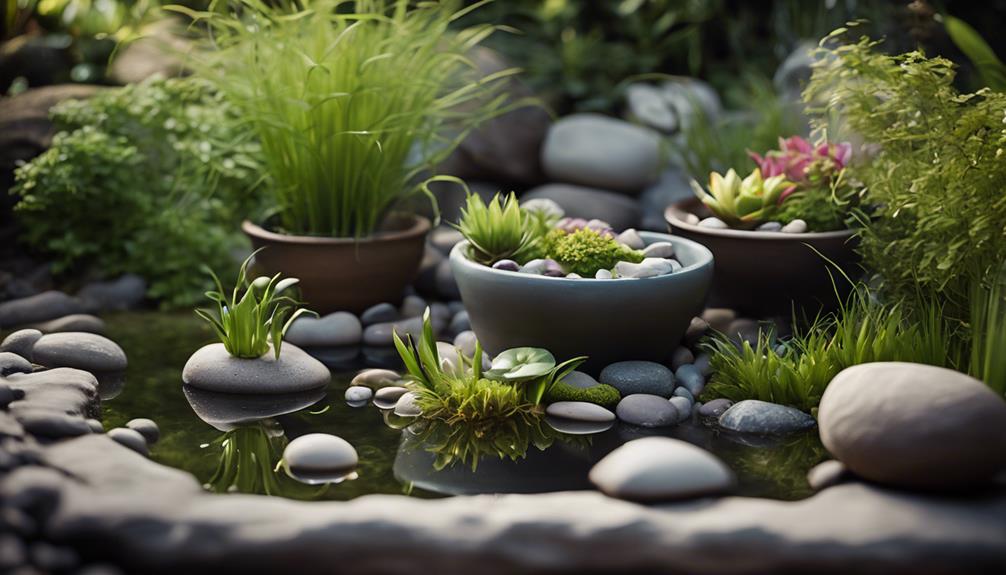
As you tend to your small yard water garden, remember that minimal maintenance is required to keep your container thriving.
You can easily rearrange plants to create a new design, and make adjustments to guarantee they're receiving the right amount of light – if needed, simply move the container to a brighter spot.
Minimal Maintenance Required
By incorporating a few simple habits into your routine, you can guarantee your small water garden remains thriving and healthy with minimal maintenance.
For instance, topping off the water every few days to replace evaporated liquid is essential to maintain the ideal water level in your mini water garden.
Additionally, occasional cleaning of the pump and filter will prevent debris buildup and safeguard a healthy ecosystem.
Regular watering is also vital, with a general rule of thumb being to add 1-2 inches of water daily, depending on climate and temperature.
Fertilizing your aquatic plants with a balanced, water-soluble fertilizer applied at half the recommended strength will promote healthy growth without burning your plants.
By adopting these simple habits, you'll be able to enjoy your water garden without breaking a sweat.
Plant Rearrangement Options
When revamping your small yard water garden, you can easily reconfigure the plant arrangement in the container to achieve a fresh, visually appealing design. By rearranging your aquatic plants, you can create a new look without starting from scratch.
Consider the mature size of each plant and leave enough space for proper growth and air circulation to prevent overcrowding and disease.
Three key tips to keep in mind when rearranging your plants:
- Vary plant heights: Use bricks or empty pots to create different levels, adding depth and visual interest to your arrangement.
- Balance textures and colors: Mix plants with different textures, colors, and heights to create a visually appealing design.
- Consider the theme: Choose plants that complement or contrast with each other to create a cohesive and visually appealing arrangement that fits your water garden's style.
Remember to rotate your plants every 1-2 weeks to guarantee even exposure to sunlight and prevent leaning or uneven growth patterns.
Insufficient Light Solutions
You'll often encounter insufficient light in your small yard water garden, especially if it's situated in a shaded area, which can hinder plant growth and overall aesthetic appeal.
To combat this, you can move your container to a brighter spot or adjust the placement of your plants.
Most marginals thrive when their crowns are placed 6 inches or less beneath the water's surface, which can help compensate for low light conditions.
Alternatively, you can incorporate floating or cascading plants like water lettuce or water hyacinth, which require minimal light to thrive.
Bricks or empty pots can be used to vary the height of plants, allowing those that require more light to receive it.
Consider using a high-quality aquarium light with a low wattage, such as 5-10 watts, to provide sufficient light without overheating the water.
Water Maintenance and Mosquito Control
To maintain a thriving small yard water garden, a vital aspect is to prioritize water maintenance and mosquito control, as these tasks directly impact the overall health and enjoyment of your outdoor oasis.
You'll want to top off the water every few days to replace evaporated liquid and prevent mosquito breeding. It's also essential to maintain the right water level, as overfilling can wash out mosquito larvae, while regular water changes (10-20% every week) help maintain water quality and prevent mosquito breeding.
Regular cleaning and maintenance is crucial. Remove debris and excess nutrients that attract mosquitoes, and consider adding a pond skimmer or surface cleaner to remove debris and reduce mosquito habitat.
Natural mosquito control methods can be effective. Introduce mosquitofish (Gambusia affinis) or use specially formulated products to kill mosquito larvae. You can also incorporate mosquito-repelling plants, like citronella or lemongrass, around the water garden.
Increase water circulation to make it difficult for mosquitoes to lay eggs and reduce the risk of mosquito-borne diseases. Install a pump or aerator to achieve this.
Winterizing and Expanding Designs
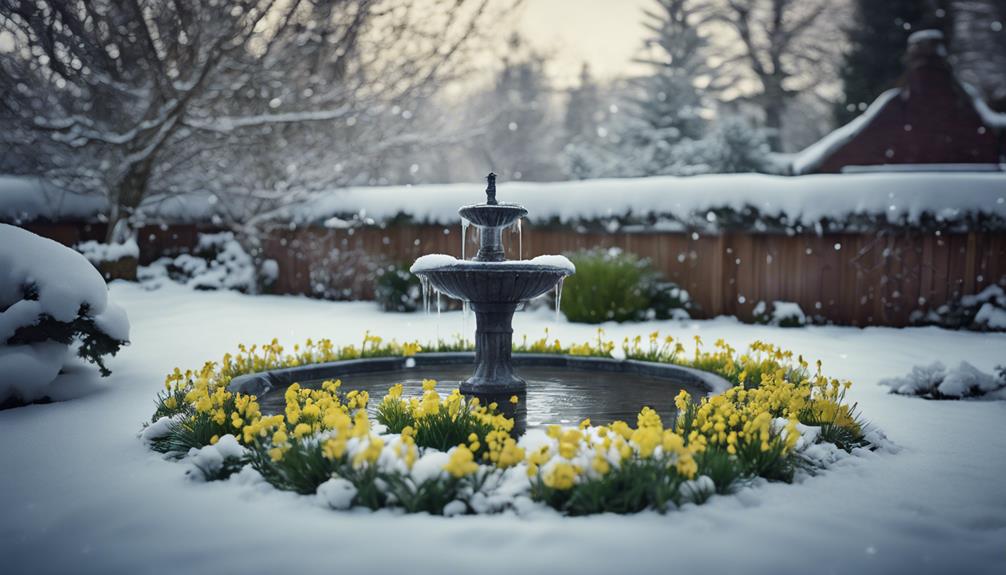
As you prepare your small yard water garden for the changing seasons, you'll need to take steps to protect your hardy plants from freezing temperatures and bring sensitive plants indoors for the winter.
By doing so, you'll not only guarantee their survival but also have an opportunity to reassess and expand your design.
This is the perfect time to ponder adding new water features, plants, or decorative elements to enhance the visual appeal of your outdoor space.
Protecting Hardy Plants
When winter approaches, it's crucial to take proactive measures to protect your hardy plants from freezing temperatures and potential damage.
As a small yard water garden owner, you want to guarantee your plants thrive even in the harshest conditions.
Provide protection from freezing temperatures: Use a birdbath-type heater or bring potted plants indoors to a cool basement or garage to overwinter. This will prevent your plants from freezing and dying.
Use frost blankets or cold frames: These will extend the growing season and protect your hardy plants from light frosts. Some hardy aquatic plants, like water lilies, can survive light frosts, but still need protection from extreme cold and ice.
Plan ahead: Consider the mature size of your plants and the space required for proper growth. Overcrowding can lead to decreased water quality and plant health, so plan your design carefully to guarantee a thriving water garden.
Bringing Plants Indoors
You'll want to carefully select a bright, yet indirect, spot for your plants indoors, certifying a consistent temperature between 50-70°F (10-21°C) to guarantee their survival during the winter months.
This allows you to continue enjoying and caring for your water plants, which can thrive as houseplants or in an aquarium until the outdoor water garden is ready again.
Before bringing them indoors, inspect your plants for pests and diseases, and treat them accordingly to prevent infestations.
Opt for species that thrive in low-light conditions, such as Chinese Evergreen or Pothos, to facilitate a seamless shift.
By bringing your plants indoors, you'll not only protect them from freezing temperatures but also have the opportunity to clean and maintain their containers and equipment, preparing them for the next outdoor season.
This winterization process also enables you to divide and repot your plants in the spring, creating new designs or sharing them with others.
With proper care, your indoor water plants will flourish, providing a beautiful and serene atmosphere in your home.
Expanding Designs
Now that your plants are safely indoors, it's time to focus on winterizing and expanding your small yard water garden design to create a more diverse and thriving ecosystem.
As you winterize, drain and clean the pond, remove plants, and store pumps and filters in a protected area to prevent damage from freezing temperatures. This is also an opportunity to expand your design. Consider adding a bog filter or a secondary pond to increase water circulation and create a more diverse ecosystem.
Incorporate a rainwater harvesting system to help reduce water consumption and maintain a healthy water level during periods of drought.
Add a cold-hardy aquatic plant species, such as hardy water lilies or cattails, to provide year-round interest and help maintain a balanced ecosystem.
Install a seasonal dock or bridge to provide additional functionality and visual interest during warmer months.
Designing for Small Spaces
Designing a small yard water garden requires a thoughtful approach to proportion, as the space's compact nature demands a harmonious balance between water feature and surrounding landscape.
When creating your compact backyard water oasis, consider the scale of the space and choose a water feature that fits proportionally, such as a small fountain or birdbath. This will create a focal point that draws the eye and creates visual interest.
To maximize space, incorporate vertical elements like wall-mounted fountains or trellises with vining plants to create a sense of depth.
You can also use a compact or miniature water feature, such as a tabletop fountain or self-contained water garden, to add the benefits of water without overwhelming the space.
Patio Ponds and Fountains
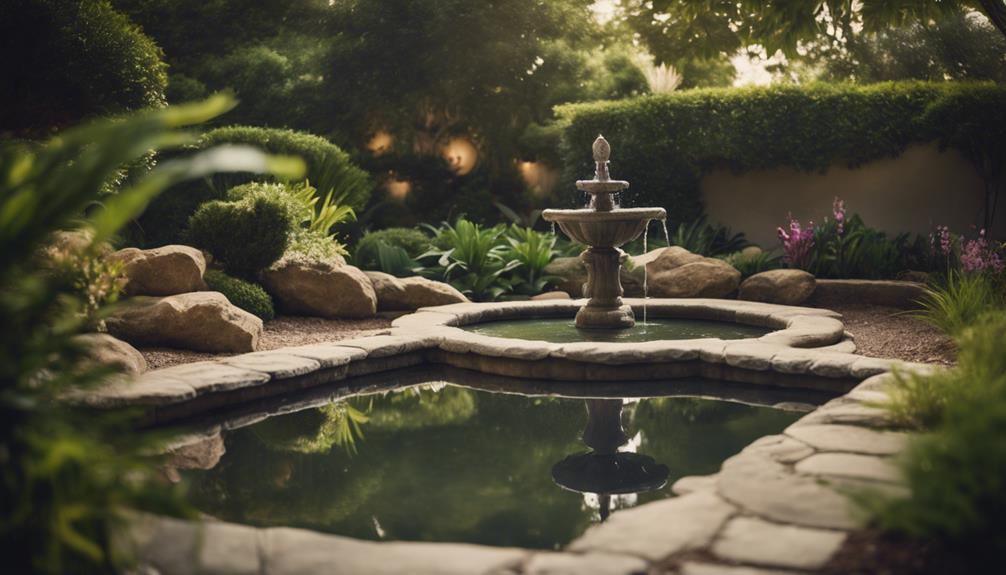
With a minimal footprint, patio ponds and fountains can bring the soothing sounds and visual appeal of water to even the smallest of outdoor spaces, making them an ideal choice for compact yards, balconies, and rooftops.
You can create a miniature pond that's as small as 40 inches in diameter, complete with flowers, water plants, and even fish. To enhance the visual appeal, consider adding decorative elements like bamboo fountains, spitting frog fountains, or underwater lights.
Flexibility in design: Patio ponds can be designed to be a focal point in your garden or a decorative piece, and can be combined with other containers on a deck or patio.
Low maintenance: Patio ponds require minimal maintenance, with tasks including topping up with water to make up for evaporation and bringing the pond inside or emptying it for winter.
Space-efficiency: Patio ponds and fountains can be as small as a few square feet, making them perfect for small yards, balconies, and rooftops.
Electrical Cost and Solar Options
As you consider the electrical cost of your small yard water garden, you'll want to weigh the pros and cons of traditional pumps versus solar-powered options.
Solar-powered pumps can be a cost-effective and eco-friendly choice, reducing your energy costs and environmental impact.
Solar Power Advantages
Running a small patio pond pump on solar power can save you a significant amount of money on your electrical bill, with some solar-powered water pumps cutting energy costs by up to 90%. This eco-friendly option is perfect for those who want to reduce their carbon footprint.
To get the most out of solar power, it is crucially necessary to choose a sunny spot for your pump, as the amount of sunlight available impacts performance.
Solar power has several benefits, including:
Cost-effective: Solar power can save you up to 90% on electrical costs, making it a budget-friendly option.
Flexibility: Solar-powered pumps allow for more flexible water feature placement, even in areas without electrical capabilities.
Efficiency: Solar-powered water pumps are available in a range of sizes to accommodate different water flow rates and feature sizes, making them an efficient option.
Cost-Effective Options
You can substantially reduce your electrical costs by opting for a cost-effective solution, such as a solar-powered pump, which can power your small yard water garden for just a few dollars a month.
This is especially true for small patio ponds, where the energy requirements are minimal. Solar-powered pumps can be an efficient and cost-effective option, using as little as 10 watts of power. Although the initial investment may be higher, it can pay for itself over time through reduced electricity costs.
When choosing a solar-powered pump, consider the amount of sunlight available in your yard. Models designed for partial shade or low sunlight conditions will guarantee peak performance.
A small solar panel with a capacity of 10-20 watts can power a mini water feature, and some systems can be purchased for under $100. By running your small water feature with a solar-powered pump, you can save up to $100 per year in electrical costs compared to traditional electric pumps.
With the added benefit of being eco-friendly, solar-powered pumps are a great choice for a cost-effective and sustainable small yard water garden.
Eco-Friendly Choices
Opting for eco-friendly choices in your small yard water garden not only reduces your carbon footprint but also helps minimize electrical costs, making it a wise decision for environmentally conscious homeowners.
By choosing solar-powered pumps and filters, you can notably reduce your reliance on traditional electrical power sources. These eco-friendly alternatives can be just as efficient, with some solar pumps capable of pumping up to 1,200 gallons of water per day.
Reduced energy costs: Solar-powered pumps can save you money on your energy bills, with an initial investment that can pay off in the long run.
Environmental benefits: By using solar power, you'll reduce your carbon footprint and contribute to a more sustainable future.
Increased independence: Solar-powered pumps can operate even in areas without electrical capabilities, giving you more flexibility in your water garden design.
Three key benefits are worth pondering:
Plant Options for Small Spaces

When designing a small yard water garden, choosing the right plants is crucial, as they can greatly impact the overall aesthetic and functionality of the space.
You'll want to select plants that thrive in small spaces and provide the desired visual appeal. Dwarf water lilies with silver-dollar-sized leaves are a popular choice, as they require minimal maintenance and thrive in shallow water.
Other options like horsetail, papyrus, sweet flag, and iris offer a range of textures and colors to enhance your space. Surprisingly, sweet potato vine, creeping jenny, pothos, and impatiens can also be used, adding a touch of whimsy and playfulness.
Impatiens can be planted right in the water garden, providing a burst of color and vibrancy. As you explore plant options, consider aquatic plants that can thrive in container water gardens, allowing for endless design possibilities.
With so many options, you're sure to find the perfect plants to create a beautiful and functional small yard water garden that feels like your own personal oasis.
Planning and Implementation Tips
To avoid costly mistakes and guarantee a successful small yard water garden, carefully assess your site's conditions, including sunlight, wind direction, and soil type, before implementing your design plan. This vital step will help you create a dynamic and thriving water garden that complements your outdoor space.
Scale it down: Small spaces require careful consideration of proportion. Choose features and plants that fit your yard's dimensions to avoid overwhelming the area.
Balance functionality and aesthetics: Verify your water garden is both beautiful and functional. Consider the sound of water, visual appeal, and maintenance requirements when selecting features like pumps and filters.
Be flexible: Be prepared to make adjustments as you implement your plan. Unforeseen site conditions or changes in your design may require adaptations to create a harmonious and thriving water garden.
Creating a Harmonious Atmosphere
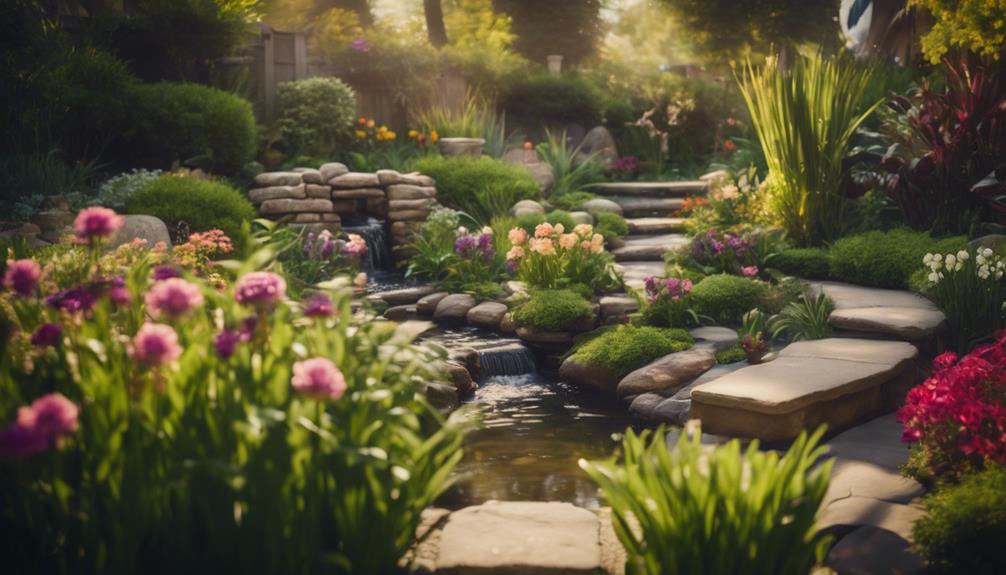
As you've carefully planned and implemented your small yard water garden, now focus on crafting a harmonious atmosphere by thoughtfully integrating visual elements, sounds, and textures that invite relaxation and serenity.
Visual elements like lush greenery, vibrant flowers, and strategically placed ornaments will create a soothing ambiance. Consider incorporating natural materials like wood, stone, and water features to add depth and character to your garden.
To further enhance the harmonious atmosphere, incorporate sounds that promote relaxation. The gentle trickle of a small fountain or the soft gurgle of waterfalls eventually flowing into a serene pond will create a calming background noise.
Textures also play a vital role in creating a harmonious atmosphere. Incorporate varying textures like smooth stones, rough bark, and soft foliage to engage your senses and create a sense of balance.
Frequently Asked Questions
What to Put in a Small Garden Water Feature?
When selecting elements for your small garden water feature, you'll want to choose a mix of aquatic plants, like water lilies and floating plants, that thrive in shallow water and provide visual interest with varying textures and colors.
How to Build a Small Water Garden?
When building your small water garden, guarantee the container is at least 6-8 inches deep, line it with a durable pond liner, and consider a water depth of 12-18 inches for ideal plant growth and circulation.
How Do I Make My Backyard Garden Successful?
You'll create a thriving backyard garden by prioritizing soil quality, incorporating visually appealing garden decor, and thoughtfully arranging plants to guarantee maximum growth, while also fostering a sense of belonging and serenity in your outdoor space.
What Is One Strategy for Getting More Produce Out of a Small Garden?
As you cultivate your small garden, think outside the box – literally! Implement crop rotation and vertical farming techniques to boost your harvest, and watch your yields skyrocket by up to 30% and 300%, respectively.
Conclusion
As you step back to admire your small yard water garden, you can't help but wonder what secrets lie beneath the surface.
The gentle ripples, the soothing sounds, and the vibrant colors all come together to create a tranquil oasis.
But, there's more to it than meets the eye.
With the right combination of container, plants, and maintenance, your water garden can become a thriving ecosystem, teeming with life.
The question is, what'll you discover next?

